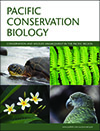Pacific Conservation Biology
Volume 28
Number 2 2022
A reduction in a localised population of common wombats due to sarcoptic mange in Tasmania, Australia raised concerns for the status of the state’s two endemic subspecies. This study showed that mange in wombats is widespread in Tasmania, with prevalence estimates based on night-time observational surveys ranging from 0 to 17.6% (average 4.4%). The potential for occasional mange epizootics and local population declines warrants on-going monitoring of mange and wombats. Advice to inform future monitoring is provided.
There is concern for the conservation status of the two endemic subspecies of common wombat in Tasmania, Australia. This study showed that wombats and roadkill are widespread in Tasmania, and that overall wombat populations have increased over the past 36 years and do not qualify for listing as Threatened. Potential risks to wombat populations such as disease and roadkill, warrant on-going monitoring and research into effective mitigation strategies.
Mass mortality events have important implications for wildlife conservation management. We estimated that at least 74 787 flying-foxes were killed from pup abandonments and extreme heat events during the austral summer of 2019–20. This was potentially the largest flying-fox die-off recorded to date, highlighting an urgent need to address casual factors and enhance intervention management.
This paper provides a first assessment of the biogeography of Galaxias maculatus spawning grounds and amphidromous spawning behaviour at non-tidal rivermouths. Consistent patterns in catchment position, vertical structuring, and environmental cues were identified that provide a sound basis for protective management to assist the conservation of this culturally important fish, which is currently in decline.
For environmental impact assessments to be effective, they must be informed by robust baseline survey data on the biodiversity affected by proposed developments. Here we show that Australian Government guidance on minimum survey effort for one of the nation’s highest profile endangered mammals is routinely being ignored in impact assessments under Commonwealth law.
Pterocymbium oceanicum is a large, emergent tree endemic to Fiji that was classified as ‘Critically Endangered’ (IUCN Red List) based on expert knowledge. Our field survey quadruples the known size of the largest subpopulation by discovering three previously unknown stands, highlighting the value and limitations of expert knowledge for conservation assessments. Furthermore, we found that the species has a narrow ecological niche and is potentially threatened by the invading African Tulip Tree, Spathodea campanulata, which should be carefully monitored.
Wallum frogs are unique as they occur in naturally acidic, oligotrophic waterbodies. These waterbodies and the habitat surrounding them are often influenced by human disturbances. This article looks at determining the suitability of anthropogenic waterbodies for wallum frogs. We found that naturally occurring waterbodies are most suited for wallum frogs.
This research provides follow-up monitoring of habitat use and preferences of a population of threatened marsupials established by an unauthorised translocation into a large urban reserve in Western Australia. We found that the population now accesses the entire area of the reserve, including some parklands, but has a preference for dense vegetation, dominated by a prickly species of Banksia.
Wailagilala is one of two ‘true’ atolls in Fiji. Our findings confirm the presence of nesting green turtle (Chelonia mydas); continued occurrence of breeding seabird populations, including documenting the fifth site in Fiji of nesting white tern (Gygis alba); and provides data on coral genera and benthic cover.





